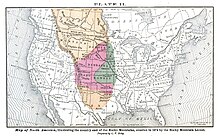
The Great Plains, sometimes simply "the Plains", is a broad expanse of flatland in North America. It is located just to the east of the Rocky Mountains, much of it covered in prairie, steppe, and grassland. It is the western part of the Interior Plains, which also include the mixed grass prairie, the tallgrass prairie between the Great Lakes and Appalachian Plateau, and the Taiga Plains and Boreal Plains ecozones in Northern Canada. Great Plains or Western Plains is also used to describe the ecoregion of the Great Plains, or alternatively the western portion of the Great Plains.

Orthoptera is an order of insects that comprises the grasshoppers, locusts, and crickets, including closely related insects, such as the bush crickets or katydids and weta. The order is subdivided into two suborders: Caelifera – grasshoppers, locusts, and close relatives; and Ensifera – crickets and close relatives.

Locusts are various species of short-horned grasshoppers in the family Acrididae that have a swarming phase. These insects are usually solitary, but under certain circumstances they become more abundant and change their behaviour and habits, becoming gregarious. No taxonomic distinction is made between locust and grasshopper species; the basis for the definition is whether a species forms swarms under intermittently suitable conditions; this has evolved independently in multiple lineages, comprising at least 18 genera in 5 different subfamilies.

The Rocky Mountain locust is an extinct species of grasshopper that ranged through the western half of the United States and some western portions of Canada with large numbers seen until the end of the 19th century. Sightings often placed their swarms in numbers far larger than any other locust species, with one famous sighting in 1875 estimated at 198,000 square miles (510,000 km2) in size, weighing 27.5 million tons and consisting of some 12.5 trillion insects, the greatest concentration of animals ever speculatively guessed, according to Guinness World Records.

Grasshoppers are a group of insects belonging to the suborder Caelifera. They are among what is possibly the most ancient living group of chewing herbivorous insects, dating back to the early Triassic around 250 million years ago.

The desert locust is a species of locust, a periodically swarming, short-horned grasshopper in the family Acrididae. They are found primarily in the deserts and dry areas of northern and eastern Africa, Arabia, and southwest Asia. During population surge years, they may extend north into parts of Southern Europe, south into Eastern Africa, and east in northern India. The desert locust shows periodic changes in its body form and can change in response to environmental conditions, over several generations, from a solitary, shorter-winged, highly fecund, non-migratory form to a gregarious, long-winged, and migratory phase in which they may travel long distances into new areas. In some years, they may thus form locust plagues, invading new areas, where they may consume all vegetation including crops, and at other times, they may live unnoticed in small numbers.

The migratory locust is the most widespread locust species, and the only species in the genus Locusta. It occurs throughout Africa, Asia, Australia and New Zealand. It used to be common in Europe but has now become rare there. Because of the vast geographic area it occupies, which comprises many different ecological zones, numerous subspecies have been described. However, not all experts agree on the validity of some of these subspecies.

The Mormon cricket is a large insect native to western North America in rangelands dominated by sagebrush and forbs. Anabrus is a genus in the shield-backed katydid subfamily in the Tettigoniidae family, commonly called katydids, bush crickets, and previously "long-horned grasshoppers". Its common name, "Mormon cricket", is a misnomer: true crickets are of the family Gryllidae.
The Nebraska Constitution is the basic governing document of the U.S. state of Nebraska. All acts of the Nebraska Legislature, the governor, and each governmental agency are subordinate to it. The constitution has been amended 228 times since it was first adopted in 1875, most notably to include the creation of a unicameral legislature.
Algona College was a private Methodist college located in Algona, Iowa. It operated from 1869 to 1875.

The Australian plague locust is a native Australian insect in the family Acrididae, and a significant agricultural pest.

Albert's swarm was an immense concentration of the Rocky Mountain locust that swarmed the Western United States in 1875. It was named after Albert Child, a physician interested in meteorology, who calculated the size of the swarm to 198,000 square miles (510,000 km2) by multiplying the swarm's estimated speed with the time it took for it to move through southern Nebraska.

Orsamus Hylas Irish (1830–1883) was an official in the United States Department of the Treasury who served as Chief of the Bureau of Engraving and Printing from 1878 to 1883.
St. Ludger Catholic Church is a historic Roman Catholic parish church in Germantown, Henry County, Missouri.
In 2012, Madagascar had an upsurge in the size of its Malagasy migratory locust populations. In November of that year, the government issued a locust alert, saying that conditions were right for swarming of the pest insects. In February 2013, Cyclone Haruna struck the country, creating optimal conditions for locust breeding. By late March 2013, approximately 50% of the country was infested by swarms of locusts, with each swarm consisting of more than one billion insects. The authorities changed the situation to plague status. According to one eyewitness: "You don't see anything except locusts. You turn around, there are locusts everywhere".

Inago no tsukudani (いなごの佃煮) is a Japanese dish featuring rice grasshoppers that are boiled in soy sauce and sugar. Inago is the Japanese word for locust. The locusts are prepared in the "tsukudani" style of cooking. The dish is traditional in Japan's inland and mountain regions, including Nagano and Fukushima, where it once served as an important nutritional supplement.
In January 2016, Argentina faced the largest locust swarm for over 60 years. Diego Quiroga, Argentina's agriculture agency’s chief of vegetative protection, said that it was impossible to eradicate the swarm, so they focused on minimizing the damage caused by it by sending out fumigators equipped with backpack sprayers to exterminate small pockets of young locusts that are still unable to fly. This method of extermination, however, is unable to wipe out pocket of locusts hidden in Argentina's large, dry forests. The swarm covered an area the size of 1,900 square miles (5,000 km2) in Northern Argentina. The locusts were expected to grow ten inches (25 cm) and mature into flying swarms by 5 February.
Dissosteira longipennis, the high plains locust, is a species of band-winged grasshopper in the family Acrididae. It is found in North America. During the 1930s, it formed enormous swarms and caused significant damage to crops in the western United States, but it is now very rare and has not swarmed since. However rare, the species is still extant, unlike the Rocky Mountain locust, the only other species of locust found in North America.

Between June 2019 and February 2022, a major outbreak of desert locusts began developing, threatening food supplies in East Africa, the Arabian Peninsula and the Indian subcontinent. The outbreak was the worst to hit Kenya in 70 years, and the worst in 25 years for Ethiopia, Somalia, and India.














